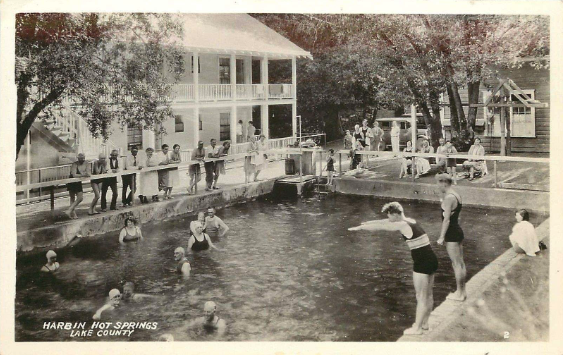Reflections: Harbin, A History of the Site
Long before this site took its current name the lands of Harbin Hot Springs was a Native American gathering spot for the Pomo Indians for around 11,000 years. After European settlers moved West and began to settle this area of Lake County North of Middletown, a man named James Madison Harbin arrived in the area and co-discovered the springs in 1852. James later returned to settle the site with his wife in 1860 and founded the resort in 1862 that bears his name today. The site was up and running by 1866 and by 1909 the resort had guest accommodations for 200 people and a cold soaking pool that inspired Bay Area folks to make the 9 hour journey by stagecoach to enjoy the pool and setting.
Some notable periods in Harbin’s evolution;
Seven-time World Heavyweight Boxing Champion Jim Jefferies and his entourage spent time staying at the resort training in 1903.
By the 1920’s Bay Area residents were making the journey to Harbin by automobile in just a few hours and paved the way for the construction of the original Walnut/ Azalea Hotel sometime in the 1920’s.
Other accommodations and improvements continued through the 1930’s as Harbin’s popularity continued to grow.
In the 1960’s the resort became known as Harbinger
In 1972 the resort was purchased by Bob Hartley otherwise known as Ishvara and author of the book “Oneness in Living”.
Watsu massage was developed by Harold Dull at Harbin in the 1980’s and is now practiced around the world.
In 1992 the Watsu Domes were developed by architect Eugene Tsui and Harold Dull as a permanent home for Harbin’s new Watsu school to teach this new massage technique.
In 2015 the Valley Fire charred 76,067 acres of land and destroyed 1,955 structures including the beloved;
Victorian Walnut/ Azalea Hotel
The Watsu Domes
The Temple
The cabins
The main pool area and sauna
Nearly all of the buildings on Harbin’s 10,000 acre property
Ishvara brought a vision of recasting Harbin Hot Springs as an intentional community and holistic spiritual healing center attracting people from all corners of the globe. Under Ishvara’s guidance Harbin continued to grow and thrive in the healing arts and as a retreat center for personal growth and development by expanding housing and lodging to accommodate individuals and groups of varying sizes. His all inclusive philosophy and ideology provided an environment supportive of ideas from differing belief systems that helped shape the architecture, gardens, art, culture, spiritual practices, and the culture of Harbin’s resident caretakers. This was evident throughout the diverse gardens, buildings, pool areas, and spiritual shrines that were beloved by Harbin’s guests who came from all over the world to soak, heal, and seek their own spiritual truths here.
As such, Harbin became a center for the development of new modes of healing and personal development, including Watsu massage. Short for water shiatsu, this technique is a form of aquatic body therapy performed in a pool allowing greater body relaxation, deeper tissue healing, and release of tension from the body.
Sadly the Valley Fire erupted on September 12th 2015 at 1 PM and quickly spread out of control until it had charred 76,076 acres of land and 1,955 structures including nearly all of Harbin’s most beloved buildings, gardens, and spiritual markers. Harbin closed down for four years to start restoration work on the main pool area, Watsu Domes, Grove Cabins, and other infrastructure. Then after four long years Harbin partially reopened including the main pool area to the public in January of 2019 while the reconstruction of the main side buildings moved ahead. Only to be shuttered again in one year later due to the Covid-19 global pandemic.

